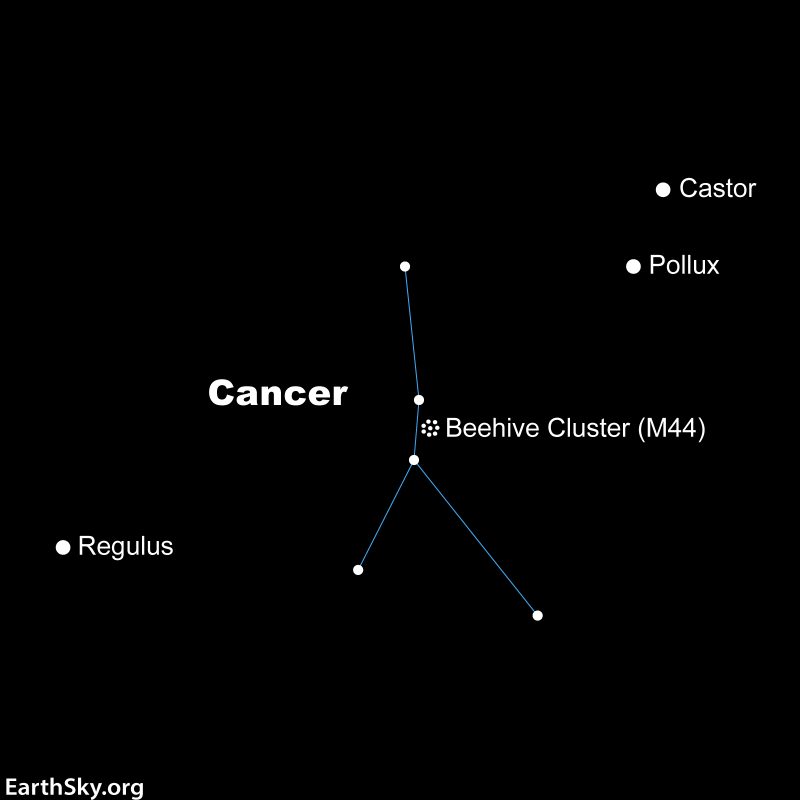How to find Cancer the Crab
There’s a good chance that you’ve never seen Cancer the Crab. It’s the faintest of the 12 constellations of the zodiac. To see Cancer, you need to look between Gemini‘s two brightest stars Castor and Pollux, and Leo the Lion’s brightest star Regulus. Once you’ve found Cancer – if your sky is dark – you can see the wonderful open star cluster called the Beehive. It contains some 1,000 stars.
So, let’s suppose you have identified the star Regulus in Leo, and the stars Castor and Pollux in Gemini. You look between them for Cancer and see, well, nothing much. Remember, Cancer is faint. Our advice, therefore, is to look for it in a dark country sky. But, on a moonless night, Cancer is surprisingly easy to see in a dark country sky.
Last chance to get a moon phase calendar! Only a few left. On sale now.
When to look for Cancer the Crab
Cancer is always well placed for viewing in March, and it is also well placed for evening viewing in April and May. Eventually, it starts to descend into the sunset glare in June.
In early March every year, look for the constellation Cancer to be due south and highest up in the sky around 10 p.m. local time. (From the tropics, Cancer shines high overhead, and from temperate latitudes in the Southern Hemisphere, Cancer appears due north.)
Also, since the stars return to the same place in the sky about four minutes earlier each day, or 1/2 hour earlier weekly, look for Cancer to be highest in the sky in mid-March at 9 p.m. local time (10 p.m. local daylight-saving time). By late March or early April, Cancer reaches its high point for the night at 8 p.m. local time (9 p.m. local daylight-saving time).
To summarize, in the Northern Hemisphere, Cancer is best seen in the evening sky in late winter and early spring. After that, it’s lost in the sun’s glare in July and August, and then is found in the morning sky starting in September. If you’re up before dawn during a Northern Hemisphere autumn, try finding Cancer and its Beehive star cluster before sunrise.
Cancer’s famous Beehive star cluster
Cancer makes up for its lackluster stars by having within its boundaries one of the sky’s brightest star clusters, the Beehive cluster, also known as M44. Another name for the Beehive is Praesepe (Latin for manger).
In a dark sky, the Beehive looks like a tiny faint cloud to the unaided eye. As seen through ordinary binoculars, though, this nebulous patch of haze instantly turns into a sparkling city of stars. It is an open cluster, one of the nearest to our solar system. The Beehive contains a larger star population than most other nearby clusters.
The Beehive’s stars appear to be similar in age and proper motion with the stars of the V-shaped Hyades open star cluster. It’s possible the two clusters were born from two parts of a single vast cloud of gas and dust in space.
Read more: The Beehive Cluster: A swarm of 1,000 stars
A member of the zodiac
Cancer’s stature as a constellation of the zodiac has remained steadfast over the millennia. In fact, more than 2,000 years ago, the sun shone in front of the constellation Cancer during the Northern Hemisphere’s summer solstice. That’s not the case today, however. Today, the sun resides in front of the constellation Taurus when the summer solstice sun reaches its northernmost point for the year on or near June 21.
Nonetheless, Cancer still seems to symbolize the height and glory of the summer sun. To this day, we say the sun shines over the Tropic of Cancer – not the “tropic of Taurus” – on the June solstice. That’s in spite of the fact that the sun in our time passes in front of the constellation Cancer from about July 21 until August 10.
Nowadays, the sun doesn’t enter the constellation Cancer until about a month after the Northern Hemisphere’s summer solstice.
Cancer the Crab of myth
In Greek mythology, Cancer was the crab that bit the foot of the Greek hero Heracles (or the Roman Hercules). Heracles killed the crab and then the goddess Hera, who saw Heracles as her enemy, placed the crab in the heavens.
In ancient Chaldean and Platonic philosophy, Cancer was called the Gate of Men. It was through this portal that souls descend from the heavens above and into the bodies of the newly born.
Around 2,700 years ago, the sun passed in front of the Beehive cluster on the Northern Hemisphere’s summer solstice. Back then, this cluster stood at the apex of the zodiac, so perhaps it was this heavenly nebulosity that marked the Gate of Men. At present, the sun has its annual conjunction with the Beehive cluster in late July or early August.
In olden times, before the advent of light pollution, the ancients referred to the Beehive as a little cloud. The Roman author Pliny reported that when the Praesepe (the Beehive Cluster) is invisible in an otherwise clear sky, it’s a sure sign of impending storm. So the Beehive cluster once served as a celestial weather station.
Although Cancer may be the faintest constellation of the zodiac, its legacy remains intact. On a dark, moonless night, look for Cancer’s faint grouping of stars to spring out between the more conspicuous constellations Gemini and Leo.
Constellations of the zodiac
Taurus the Bull
Gemini the Twins
Cancer the Crab
Leo the Lion
Virgo the Maiden
Libra the Scales
Scorpius the Scorpion
Sagittarius the Archer
Capricornus the Sea-goat
Aquarius the Water Bearer
Pisces the Fish
Aries the Ram
The 13th constellation of the zodiac: Ophiuchus the Serpent Bearer
Bottom line: Cancer the Crab is one of the 12 constellations of the zodiac. Learn how to find it in your sky, plus its star cluster, mythology and more.

